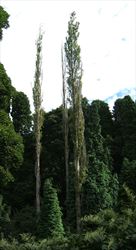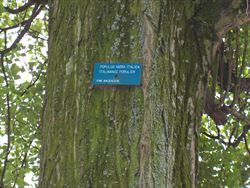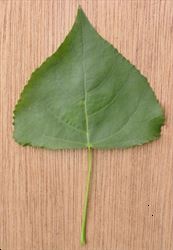Click on images to enlarge

Populus nigra 'Italica'. Note very slender, sparse crown. Northumberland, UK. By MPF (Own work) [CC BY-SA 3.0 (http://creativecommons.org/licenses/by-sa/3.0) or GFDL (http://www.gnu.org/copyleft/fdl.html)], via Wikimedia Commons

Bark and trunk. By JoJan, wikimedia.org CC BY-SA 3.0

Leaf. By Rasbak (Own work) [GFDL (http://www.gnu.org/copyleft/fdl.html) or CC-BY-SA-3.0 (http://creativecommons.org/licenses/by-sa/3.0/)], via Wikimedia Commons
Scientific Name
Populus nigra L. 'Italica'
Synonyms
Populus nigra L.Populus nigra L. var. italica du Roi
Family
Salicaceae
Common Names
black cherry, black poplar, evergreen Italian poplar, Italian poplar, Lombardy poplar
Origin
Native to north-western Africa (i.e. northern Algeria, Morocco and Tunisia), Europe (i.e. Austria, Belgium, Czechoslovakia, Germany, Hungary, the Netherlands, Poland, Switzerland, France, north-eastern Spain, Albania, Bulgaria, Greece, Italy, Romania, Yugoslavia, Belarus and Ukraine) and western and northern Asia (i.e. northern Iran, Turkey, Armenia, Azerbaijan, Georgia, Russia, Kazakhstan, Tajikistan and western China).
Naturalised Distribution
Widely naturalised in southern and eastern Australia (i.e. in the sub-coastal districts of south-eastern Queensland, in some parts of eastern New South Wales, in the ACT and eastern Victoria, in south-eastern South Australia and in the coastal districts of south-western Western Australia).
Also widely naturalised in North America.
Notes
Lombardy poplar (Populus nigra 'Italica') is regarded as an environmental weed in the ACT, New South Wales, Victoria, South Australia and Western Australia.

